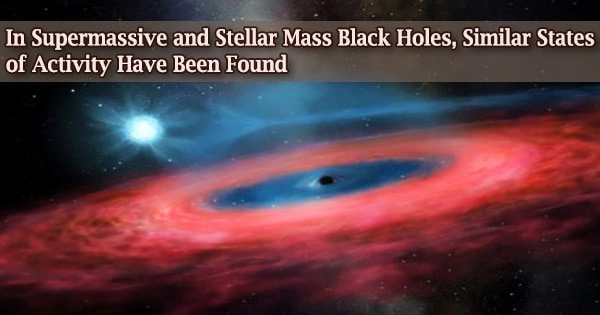Juan A. Fernández-Ontiveros of the Istituto Nazionale di Astrofisica (INAF) in Rome and Teo Muoz-Darias of the Instituto de Astrofisica de Canarias (IAC) in Canarias have written an article in which they describe the different states of activity of a large sample of supermassive black holes in galaxies’ centers.
The behavior of their nearest “relative,” stellar mass black holes in X-ray binaries, was used to classify them. The study was recently published in the Royal Astronomical Society’s journal Monthly Notices (MNRAS).
Black holes can have masses ranging from a few times the mass of the sun to thousands of millions of solar masses. For decades, scientists have been trying to figure out how to interpret their activity cycles from a global viewpoint.
The stellar mass variety is found in binary systems with a companion star from which they suck out the gas required to sustain their activity, whereas the supermassive variety is found in the galactic nuclei and feeds on the gas, dust, and stars that fall into the galactic nucleus’ gravitational well.
Black holes with a stellar mass evolve quickly. They go through different stages or phases during their activity cycles, which normally span a few months or years. Changes in the features of their accretion discs (where hot gas gathers before going into the black hole), winds, and material jets describe them.
There are two main states, the first of which is dominated by the accretion disc, and the second of which is dominated by the jet. The ‘soft’ state is marked by the disc’s thermal emission, whereas the ‘hard’ state is marked by the disc cooling down and the emission at radio frequencies being highly intense.
The study demonstrates the presence of accretion states in supermassive black holes, with properties very similar to those we know from stellar mass black holes, where the systems in the ‘soft’ state harbour a bright disc, and those in the ‘hard’ state show intense radio emission while the disc is very weak.
Juan A. Fernández-Ontiveros
Because they are significantly more massive than their stellar mass counterparts, supermassive black holes grow much more slowly. As a result, demonstrating the presence of states and transitory events in these would require millions of years of observation, because the changes over a human lifetime would be too minor to measure.
Furthermore, galaxies’ nuclei are densely populated places, and light absorption by hydrogen and dust covers and hides the radiation from the accretion disc around the central black hole.
Fernández-Ontiveros and Muñoz-Darias used a sample of 167 active galaxies in their work to accurately identify the possible accretion states of supermassive black holes.
The accretion disc’s emission is not directly detectable, but the center region’s gas absorbs and processes the radiation in the form of spectral lines. It is possible to test the presence of the disc in these objects by looking for oxygen and neon lines in the mid-infrared.
“The study demonstrates the presence of accretion states in supermassive black holes, with properties very similar to those we know from stellar mass black holes, where the systems in the ‘soft’ state harbour a bright disc, and those in the ‘hard’ state show intense radio emission while the disc is very weak,” explains Juan A. Fernández-Ontiveros, an INAF researcher who was trained at the IAC.
“This work opens a new window to understand the behaviour of material (gas) when it falls into black holes with a wide range of masses, and helps a more precise understanding of the activity cycles of the supermassive black holes which are in the centres of most galaxies,” adds Teo Muñoz-Darias, a researcher at the IAC.





